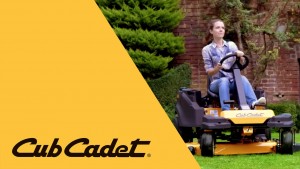Need to put a new blade on your Cub Cadet mower? You may be surprised to find more than one choice for your deck. Which blade will best fit your needs?
How Many Blades Do I Need?
Blades are sold individually. Replacing a single blade on a multi-blade deck is fine as long as it uses the same design as the other blades. If you’re switching between designs, replace all the blades at the same time.
What Type of Blade Do I Need?
Blades can be ordered by model, or by determining what will fit correctly. Blade size is measured from the long end of the blade. This will be slightly less than the deck size on single blade mowers because there needs to be a little clearance between the blade and the mowing chamber. The holes in the blade should also match the blade adapter. Most recent Cub Cadets use a star-shaped mount for the blade to help keep it from turning.
When Do I Need a New Blade?
The blade should be balanced and have an even, flat edge that’s as sharp as a butter knife. If the blade is bent, chipped or too thin to hold the edge, it needs to be replaced. If your mower is leaving an uneven finish or it’s vibrating abnormally, the blades should be checked for damage.
How long will a blade last? That’s hard to say. A new blade can be ruined on its first use if it hits a hard object, and sandy soil can quickly erode the blade’s surface. Depending on the conditions, a residential user may get a couple seasons out of a blade, while a commercial operator may need to replace blades after a couple months.
What’s the Difference Between Blades?
Cub Cadet makes several blade designs. There’s a good chance at least a couple of these designs will come in sizes that fit your mower, whether you have a small push model, a commercial ZTR or anything in between.
The main difference between these designs is lift. If you’re using the side discharge chute, the blade needs to cut the grass and fling it toward the opening in the deck. If you want to mulch, the blade needs to throw the clippings upward as it cuts through the grass. As the clippings fall back down, the blade cuts them again to make them smaller. This recutting also makes the clippings more compact, making them ideal for bagging, but the blade also needs to throw the clippings outward so that they exit the deck opening to gather in the bag. Each blade design is tuned to deliver just the right amount of upward and outward force to work with the deck shape and its intended use.
3-in-1
These provide enough lift to mulch and bag but still work with the side discharge chute. They don’t perform as well as a purpose-built blade for all these activities, but they work well enough that you can switch between modes without having to change the blade.
2-in-1
These blades are built for mulching and side discharge. There really isn’t much difference between these and 3-in-1 blades as far as design; they’re just made for mowers that aren’t designed to bag.
Hi-Lift and Mulching
More lift means better mulching, but these blades don’t work well for side discharge.
Extreme Blade
The toothed edges of this blade increases the cutting surface, which creates a finer mulch, helping it mix in with the turf. This fine cut also results in more compact clippings, letting the bag hold more before needing to be emptied. The unique edges help throw small clippings away from the blade, which means more clippings will end up in the bags than on the ground.
Making Blade Removal Easier
Normally, blade removal involves wedging a piece of wood between the deck and the blade and hoping this keeps the blade from moving while you remove the center bolt. Cub Cadet makes a tool specifically for blade removal that makes the process easier and safer since it won’t slip.
Where Can I Get New Blades?
www.cubparts.com carries everything Cub Cadet including their full line of blades and the company’s own blade removal tool. Our site makes it easy to find compatible blades for your mower by letting you search by model, and we can ship them to any address in the U.S. and Canada.

